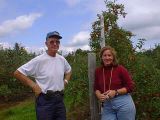Profile
Conscientious Apple Farming Means Growers Become Scientists
 About 45 years ago, standard practice in apple orchards was to spray DDT and lead arsenic every ten days, by the calendar, over the entire orchard. The strategy was to beat pests into submission and minimize lost crops. On some farms, the chemicals have changed but the methods have barely advanced, spraying when word gets out of a new infestation. Not so, however, for Peter, Ann and Donald Ednie of Franklin Centre, Québec. Their consistently productive apple orchards are managed using the Integrated Pest Management (IPM) approach.
About 45 years ago, standard practice in apple orchards was to spray DDT and lead arsenic every ten days, by the calendar, over the entire orchard. The strategy was to beat pests into submission and minimize lost crops. On some farms, the chemicals have changed but the methods have barely advanced, spraying when word gets out of a new infestation. Not so, however, for Peter, Ann and Donald Ednie of Franklin Centre, Québec. Their consistently productive apple orchards are managed using the Integrated Pest Management (IPM) approach.
The shift to IPM has been gradual for the Ednies, prompted by economic pressures and the desire for efficiency. IPM has meant that the Ednies have had to act as researchers, analysts and implementers in a program designed with an emphasis on maintaining fruit quality and productivity rather than complete "pest control".
The premise underlying IPM is that a certain low level of pest presence is often cheaper and safer than the measures necessary to eliminate them entirely. Under IPM, traps, chemicals and biological controls are all combined and used as precision tools to monitor and maintain this balance.
The Ednies must deal with weeds, mice, deer, insects, such as plum circulio and red mites, and fungal infections such as scab. Weather conditions, particularly rain and hail, can also throw a wrinkle into their planning process.
Pass mouse over this image...
 Key to IPM is knowing the localized levels of pest infestation. Ann sets and checks several types of traps at many points in the orchards. The traps use olfactory and visual bait to catch insects on a sticky surface, or disrupt their metabolism, collecting them for counting. The results from these traps are monitored, graphed and checked against a tolerable level (threshold). If the bug population in a certain area is above the threshold, then swift and precise action is taken with a chemical or biological insecticide.
Key to IPM is knowing the localized levels of pest infestation. Ann sets and checks several types of traps at many points in the orchards. The traps use olfactory and visual bait to catch insects on a sticky surface, or disrupt their metabolism, collecting them for counting. The results from these traps are monitored, graphed and checked against a tolerable level (threshold). If the bug population in a certain area is above the threshold, then swift and precise action is taken with a chemical or biological insecticide.
Armed with knowledege of the bugs' life cycle, the spraying could take place at any hour depending on when the bugs are active and vulnerable. Some pests are easier to wipe out outside of the 9 to 5 working day, and they certainly don't break for weekends. Likewise, fungicides are usually applied under the cool conditions of early morning or evening in order to increase efficiency. These fungicides have to be maintained with an eye to rainfall, UV radiation, and the growth of plants. If it rains, for instance, the Ednies have from 48 to 96 hours to re-apply fungicides, depending on the type used. Under IPM, chemical applications are reactions to conditions, not slaves to the calendar.
 Other tools and allies are available to the Ednies. Their reduced use of chemicals helps maintain a population of predator insects, such as ladybugs, lacewings, predator mites, aphid midges and wasps. These predators are also attracted to food, and tolerable levels of pests can feed them and keep their numbers stable. Meticulous mowing and removal of grass and weeds with herbicides reduces mouse habitats, driving them away from sensitive crops.
Other tools and allies are available to the Ednies. Their reduced use of chemicals helps maintain a population of predator insects, such as ladybugs, lacewings, predator mites, aphid midges and wasps. These predators are also attracted to food, and tolerable levels of pests can feed them and keep their numbers stable. Meticulous mowing and removal of grass and weeds with herbicides reduces mouse habitats, driving them away from sensitive crops.
The Ednies also take part in the hiring of an agronome on a cooperative basis with other growers. They and other local growers consult her on soil and plant tissue analysis, recommended plans for fertilization and spraying, and the nature of specific pests.
Ann and Peter agree that successful, responsible apple farming rests on a willingness to pay attention to all the data, and to let their schedules flow around that of the orchard. Responsible apple farming, for the Ednies, is a profession worth working overtime.